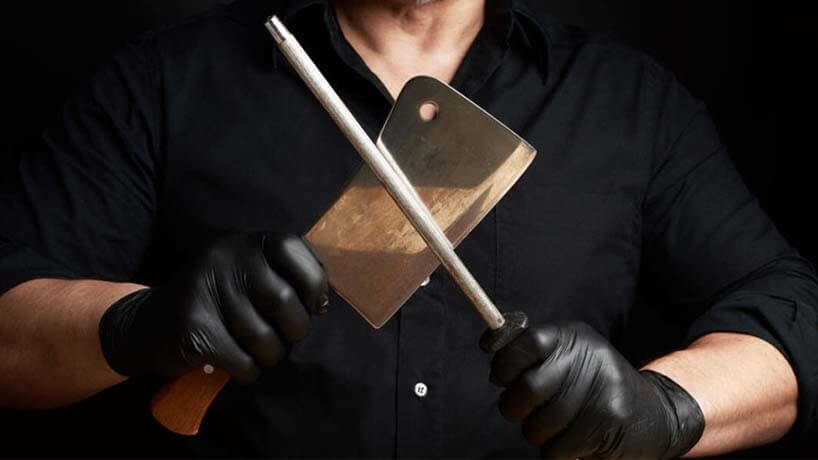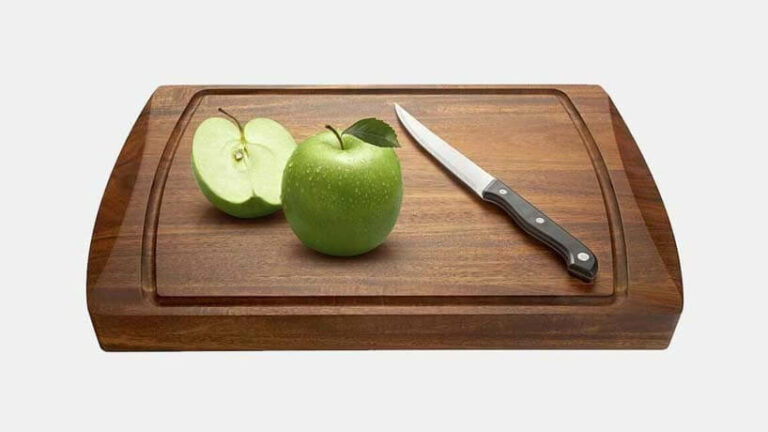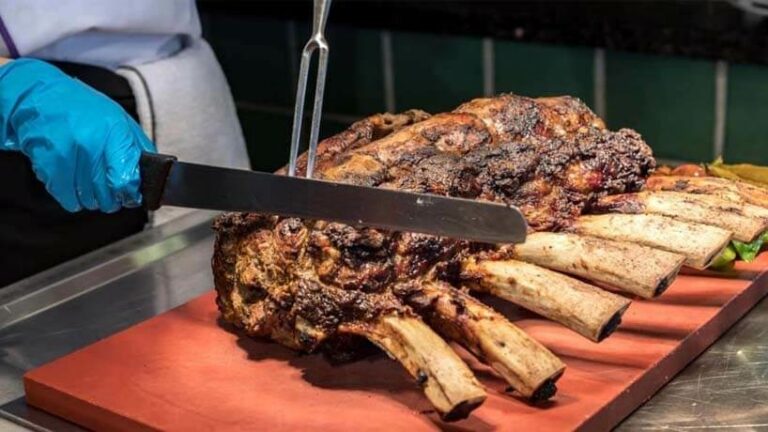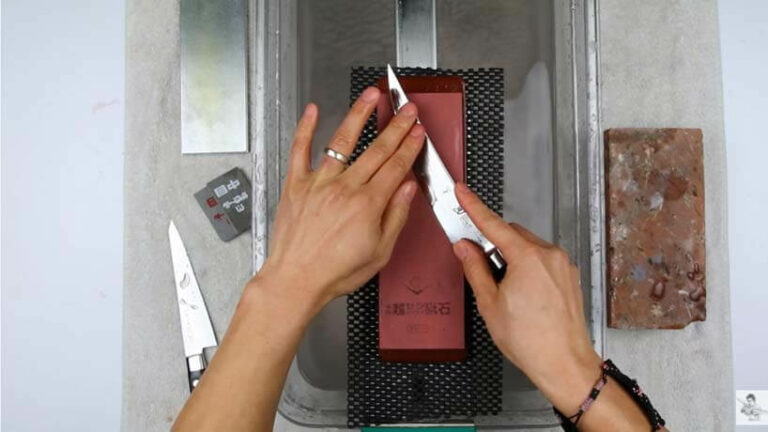Kitchen knives an essential part of your tools when cooking. This means you want them in top condition. Learn how to properly take care of them with this guide. Knowing how to sharpen a kitchen knife is an important skill to anyone who wants to cook. Cutting ingredients is very important in cooking. This means you need sharp knives. This can be a problem since every time you cut, you slowly dull your knife.
The main thing to remember about knife sharpening it that you’ll want to do it on a regular basis. Depending on how much wear-and-tear you’re putting your knife through, you’ll want to do home sharpening at least once a month and sending it out for a professional sharpening once a year. If you’re interested in how to properly take care of your knife’s edge, we can provide you with the basics in this article.
Some Clarification
There are actually two things you need to do to ensure that your knife keeps a cutting edge: sharpening and honing. Sharpening is the act of removing material from the knife edge so that a cutting edge can be created. This is usually done with a variety of tools.
Too much sharpening or improper sharpening can cause damage to a knife, so it is recommended that you learn to do it properly. Honing actually seems similar to sharpening since they use the same tools. However, what honing does is actually straighten out the edge of your knife.
A knife edge can get blunted when you cut and slowly curve away microscopically. Honing straighten the edge out so that you can actually cut with it. Sharpening and honing are often packed in together so it can be confusing. For easy understanding, this article does not differentiate since both of these actions can be done at the same time.
Getting Into The Details
The first thing that you need to know in how to properly sharpen a kitchen knife is to have the right tools. It can be very tempting to be lazy and buy an automatic knife sharpener. We advise that you don’t unless you’ve had years of experience in sharpening. The main problem is that these sharpeners are very good at removing material from your knife.
Without an experienced hand guiding it, these can damage your knife in an eyeblink. As a beginner at sharpening knives, you have basically two options: a honing rod and a sharpening stone. Both of these can provide you with the sharpening experience that you need.
You’ll need to pick the right one for your purposes though. Honing rods are available in three different types: steel, ceramic, and diamond. Steel honing rods are inexpensive and easily available. The other two options are pricier, but can be a lot more effective than the other options.
The other factor to consider when buying a honing rod is the length of both the steel and handle. You want a rod that you can be comfortable using so you should try handling it a bit to see if you can work with it properly. As for sharpening stones, there are four grades for you to choose from. This is determined by their grit rating.
The coarse stones at 220 grit are the most useful in getting of the material on your knife’s edge. This is very good at removing chipped edges and setting a new edge. Medium grit stones are at 1000 to 1500 grit. This is your main go-to stone for ordinary sharpening and we recommend that you pick this one up as your starter.
Fine and very fine sharpening stones start from 4000 grit and can reach up to 8000 grit. This is when you want your knife ready for special ingredients that need to be sliced thinly like sashimi and more. Take note though that the sharper the edge, the quicker it is to get blunted.
Sharpening With a Rod
Now that you have your sharpening tools, you’re going to need to know how to use them. First, we’ll discuss how to sharpen a kitchen knife with a rod. The key thing about using a honing rod is that it is best to do it every time you use your knife. It’s actually pretty quick when you use a honing rod so it isn’t that much of a hassle.
Now, most people like to copy what they see on TV and in the movies and hone their knives by just rubbing the rod and knife against each other. That’s the wrong way to do it and may even damage the knife. The proper way to sharpen with a honing rod is to first hold the honing rod on the counter. The tip should be solidly on the counter, with the rod being completely perpendicular.
The next step is to set the knife blade 45 degrees from the rod. This won’t be the final position but it is a good starting point. You should also set the blade as near the handle as possible. You then twist up, reducing the degrees to around 20 or so. To imagine it better, it should be halfway between the original position that you laid the knife at.
At this point, you should remember that the blade should be pointing downwards at the counter. Then we go to the main step which is to draw the knife towards you, while also moving down. The move should be smooth and fluid, while keeping in contact with the honing rod. It should end with the knife leaving the rod.
You should do this movement around four to five times if you already sharpen regularly. If you have gone some time without sharpening, then you should up it to eight or ten. Do the same thing on the other side. Take note though that you will need to check the honing rod whether it is still in good condition. When it gets dulled, it is a good move to replace it.
Sharpening With a Stone

Now we move on to how to sharpen a kitchen knife with a stone. Sharpening with a stone is a lot more difficult process. You should set aside some dedicated time to do sharpening with stones. The main thing you need to remember with sharpening stones is to keep them wet. They are porous and you will need the water to avoid unnecessary friction with the knife.
Pour water on the stone until no air bubbles come out. You can then begin with the sharpening by positioning the knife at a 22 degree angle above the stone and at the very edge of the blade. The knife should be in your dominant hand and then put your other hand’s thumb on where the knife edge meets the stone. The other fingers on your hand should be on the blade to keep it steady.
The sharpening movement is to draw the knife back smoothly, with even pressure applied on the stone. It should look like you are slicing the stone. Do this for one side of the knife until you feel that the knife is sharp enough. You can then turn it over and do it for the other side. Remember to wet the stone every few minutes to ensure that the sharpening goes as smoothly as possible.
A Special Case
There are times when you need to learn how to sharpen a ceramic kitchen knife. Ceramic knives are a special case since they are unlike normal steel knives. People love using ceramic knives because they can be very sharp. Ceramic knives have a sharpness rating of 9.5. For comparison, steel knives are often rated at around 6.5 while diamond-edged knives get the perfect 10.
Many claim that this sharpness is permanent and does not require any additional sharpening. The truth is that ceramic edges usually end up getting blunt in time. The only way to ensure that your ceramic knife stays sharp is to use a diamond sharpening stones. You also need to be very careful when sharpening.
This is mostly because ceramic is very brittle. Exert too much pressure and you may end up damaging the knife. When sharpening, keep in mind the same procedures above in using stones: keep the stone wet and use your hand to steady the blade so that the sharpening is done evenly.
Professional Handling
Home sharpening can only do so much though. You will need to take your knives to a professional sharpener at least once a year. They have knife grinders and specialized tools to ensure that they get the job done. Additionally, they have the skills and years of experience to know how to properly take care of your knife. If your knife gets severely damaged though, like a major chip or the tip snaps, then you should also seriously consider taking your knife to a professional.
Keeping Sharp
Knowing how to sharpen a kitchen knife is an important piece of knowledge that will enable you to get the most out of your kitchen knife. From picking the right piece of sharpening equipment to proper usage, we hope that this article provides you with the information that you need to ensure that you can take care of your kitchen knife properly.







